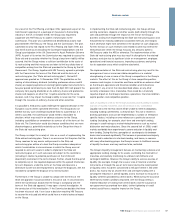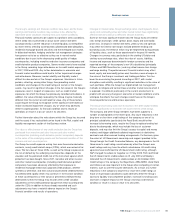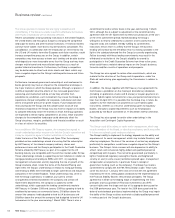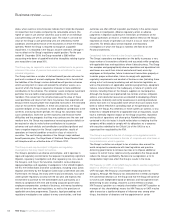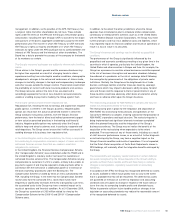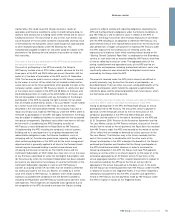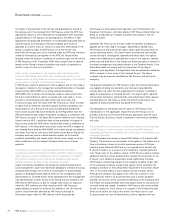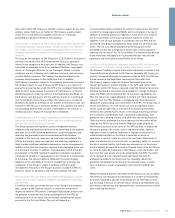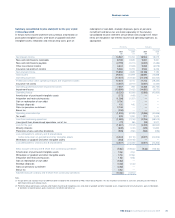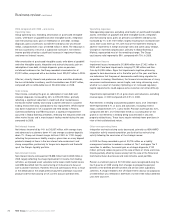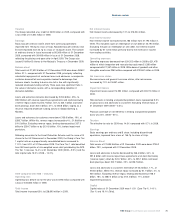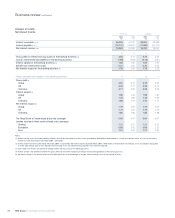RBS 2009 Annual Report Download - page 68
Download and view the complete annual report
Please find page 68 of the 2009 RBS annual report below. You can navigate through the pages in the report by either clicking on the pages listed below, or by using the keyword search tool below to find specific information within the annual report.RBS Group Annual Report and Accounts 200966
Business review continued
There is currently no restriction in respect of deferred tax assets
recognised by the Group for regulatory purposes. Changes in
regulatory rules may restrict the amount of deferred tax assets that can
be recognised and such changes could lead to a reduction in the
Group’s Core Tier 1 capital ratio. In particular, on 17 December 2009,
the Basel Committee published a consultative document setting out
certain proposed changes to capital requirements (see the risk factor
headed “The Group’s business performance could be adversely
affected if its capital is not managed effectively or if there are changes
to capital adequacy and liquidity requirements” above). Those
proposals included a requirement that deferred tax assets which rely on
future profitability of the Group to be realised should be deducted from
the common equity component of Tier 1 and therefore not count
towards Tier 1 capital.
Risks relating to the Group’s participation in the APS
Owing to the complexity, scale and unique nature of the APS and the
uncertainty surrounding the duration and severity of the current
economic recession, there may be unforeseen issues and risks that are
relevant in the context of the Group’s participation in the APS and in the
impact of the APS on the Group’s business, operations and financial
condition. In addition, the assets or exposures to be covered by the APS
may not be those with the greatest future losses or with the greatest
need for protection.
Since the APS is a unique form of credit protection over a complex
range of diversified Covered Assets in a number of jurisdictions and
there is significant uncertainty about the duration and severity of the
current economic recession, there may be unforeseen issues and risks
that may arise as a result of the Group’s participation in the APS and
the impact of the APS on the Group’s business, operations and financial
condition cannot be predicted with certainty. Such issues or risks may
have a material adverse effect on the Group. Moreover, the Group’s
choice of assets or exposures covered by the APS was based on
predictions at the time of its accession to the APS regarding the
performance of counterparties and assumptions about market
dynamics and asset and liability pricing, all or some of which may prove
to be inaccurate. There is, therefore, a risk that the Covered Assets will
not be those with the greatest future losses or with the greatest need for
protection and, as a result, the Group’s financial condition, income from
operations and the value of any securities may still suffer due to further
impairments and credit write-downs.
There is no assurance that the Group’s participation in the APS and the
issue of £25.5 billion of B shares and, if required, the £8 billion
Contingent B shares will achieve the Group’s goals of improving and
maintaining the Group’s capital ratios in the event of further losses.
Accordingly, the Group’s participation in the APS and the issue of
£25.5 billion of B shares and, if required, the £8 billion Contingent B
shares may not improve market confidence in the Group and the Group
may still face the risk of full nationalisation or other resolution
procedures under the Banking Act.
The Group’s participation in the APS, together with the recent issue of
£25.5 billion of B shares and, if required, the £8 billion Contingent B
shares, has improved its consolidated capital ratios. However, the Group
remains exposed to a substantial first loss amount of £60 billion in
respect of the Covered Assets and for 10 per cent. of Covered Assets
losses after the first loss amount. In addition, as mentioned in the
previous risk factor, the assets or exposures to be covered by the APS
may not be those with the greatest future losses or with the greatest
need for protection. Moreover, the Group continues to carry the risk of
losses, impairments and write-downs with respect to assets not covered
by the APS. Therefore, there can be no assurance that any regulatory
capital benefits and the additional Core Tier 1 capital will be sufficient to
maintain the Group’s capital ratios at the requisite levels in the event of
further losses (even with the £8 billion Contingent B shares). If the
Group is unable to improve its capital ratios sufficiently or to maintain its
capital ratios in the event of further losses, its business, results of
operations and financial condition will suffer, its credit ratings may fall,
its ability to lend and access funding will be further limited and its cost
of funding may increase. The occurrence of any or all of such events
may cause the company’s share price to decline substantially and may
result in intervention by the Authorities, which could include full
nationalisation or other resolution procedures under the Banking Act.
Any compensation payable to shareholders would be subject to the
provisions of the Banking Act, and shareholders may receive no value
for their shares.
In the event that the Group’s Core Tier 1 capital ratio declines to below 5
per cent., HM Treasury is committed to subscribe for up to an additional
£8 billion of Contingent B shares if certain conditions are met. If such
conditions are not met, and the Group is unable to issue the £8 billion
Contingent B shares, the Group may be unable to find alternative
methods of obtaining protection for stressed losses against severe or
prolonged recessionary periods in the economic cycle and improving its
capital ratios, with the result that the Group may face increased risk of
full nationalisation or other resolution procedures under the Banking Act.
In the event that the Group’s Core Tier 1 capital ratio declines to below 5
per cent., HM Treasury is committed to subscribe for up to an additional
£8 billion of Contingent B shares if certain conditions are met. Such
conditions include that the Commission’s decision that the State aid is
compatible with article 87 of the consolidated version of the Treaty
establishing the European Community continues to be in force, that the
Commission has not opened a formal investigation under article 88(2) of
such Treaty in relation to the possible misuse of State aid, that there has
been no breach by the company of the State Aid Commitment Deed
and that no Termination Event has occurred.
If such conditions are not met, and the Group is unable to issue the £8
billion Contingent B shares, the Group may be unable to find alternative
methods of obtaining protection for stressed losses against severe or
prolonged recessionary periods in the economic cycle and improving its
capital ratios, with the result that the Group may face increased risk of
full nationalisation or other resolution procedures under the Banking Act.
In these circumstances, if the Group is unable to issue the £8 billion
Contingent B shares, the Group will need to assess its strategic and
operational position and will be required to find alternative methods for
achieving the requisite capital ratios. Such methods could include an
accelerated reduction in risk-weighted assets, disposals of certain
businesses, increased issuance of Tier 1 capital securities, increased
reliance on alternative government-supported liquidity schemes and
other forms of government assistance. There can be no assurance that
any of these alternative methods will be available or would be
successful in increasing the Group’s capital ratios to the desired or
requisite levels. If the Group is unable to issue the £8 billion Contingent
B shares, the Group’s business, results of operations, financial condition
and capital position and ratios will suffer, its credit ratings may drop, its
ability to lend and access funding will be further limited and its cost of
funding may increase. The occurrence of any or all of such events may
cause the price of its securities to decline substantially and may result



